Japanese-style souffle cheesecake. This cotton soft cheesecake is full of creamy cheese flavour with a light melt-in-your mouth texture. The softest cheesecake you'll ever have!
Jump to:
Why make this cheesecake?
I am a cheesecake lover. To be honest, when it comes to cheese I love everything and this Japanese souffle cheesecake is no exception. The first time I tried a Japanese-style cheesecake was when the Uncle Tetsu's chain store opened in Sydney. There was ALWAYS a massive line to get a bit of this famous cheesecake, and lucky enough I got my hands on some. It was life-changing. The texture is so unique, soft, and fluffy yet rich and cheesy enough to be called a cheesecake.
I've been hooked ever since!
On the other hand, making this cheesecake was a different story. Me and my Japanese souffle cheesecake recipe has had a rough past. This cake looks deceivingly simple. No base, just a nice fluffy sponge, what can be so hard?
This cake is prone to sinking, dense bottoms, and cracked tops. Because the texture is so unique it makes it harder to nail. On top of that If you want that perfect-looking cheesecake it's even harder. I have tried SO many recipes, and in the end, I've found my very own. I've included all the tips and tricks I found useful to recreate this cake. I promise you you'll have the fluffy cheesecake of your dreams!
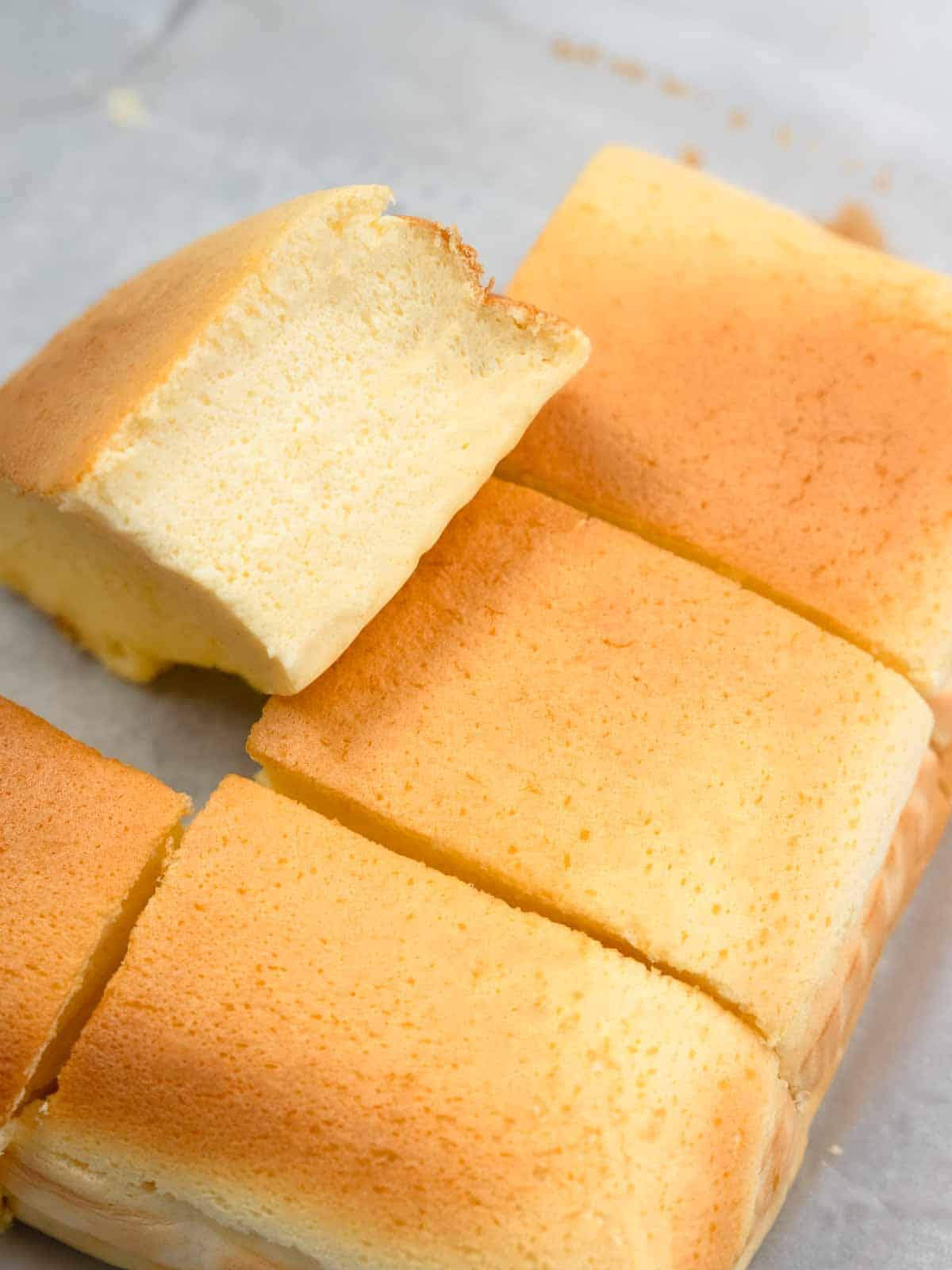
Tips for the perfect Japanese cheesecake
Here are a couple of tips that will help you reach cheesecake success!
Cake Batter
It is important to make sure your cake batter is smooth and lump free before folding in your egg whites. This means making sure you:
- Melt the cream cheese and butter sufficiently so there are no lumps
- Sift the flour into the batter to remove floury clumps
If you find there are still clumps in your batter after melting and sifting you can pass the batter through a fine meshed sieve. This will smoothen out your batter.
Whipping Egg Whites
This is one of the most important steps when making Japanese cheesecake as it gives the cake its signature fluffy texture.
When whipping the egg whites make sure that it comes to soft peaks. Having a stable meringue will prevent your cake from cracking while giving it a perfect rise. If you whip the meringue to stiff peaks it will increase the risk of your cake cracking, so make sure you stop when it reaches soft peaks.
Once you reach soft peaks you want to beat the egg whites on low for 2 minutes or so to stabilise the meringue. This ensures there are no large air bubbles in your batter, preventing the possibility of cracking.
If you find that your egg whites aren't whipping up well you can wipe your bowl with white vinegar before adding the egg whites to the bowl and whisking. This gets rid of any grease on the bowl that prevents the egg whites from whipping to their full potential.
Folding Egg Whites
The next step is folding the meringue into the batter. We want to be careful not to deflate the air bubbles created, but also make sure that it is fully incorporated. To do achieve this I split the folding into two steps
- Add one-quarter of the meringue to the cake batter and whisk the egg whites in well. It is ok to deflate air at this point as we are just trying to lighten the batter and prepare it for folding
- Then transfer the lightened cake batter to the egg whites, before carefully folding the batter through the meringue until completely incorporated
Most recipes will tell you to add the meringue to the lightened cake batter, however I find that way it is easy to miss parts of the heavy cake batter when folding. Missed cake batter = dense uneven cake. By doing the reverse you can prevent this!
Baking
A bain-marie or hot water bath is essential for baking the cake. The hot water bath stabilizes the temperature in the oven and prevents it from being overly hot and dry. Hot and dry oven means cracked cheesecake.
Pour boiling water 1-2cm up the side of the pan. Too much water can cause excess moisture in the oven. This changes the temperature of the oven and can cause you to under-bake the cake.
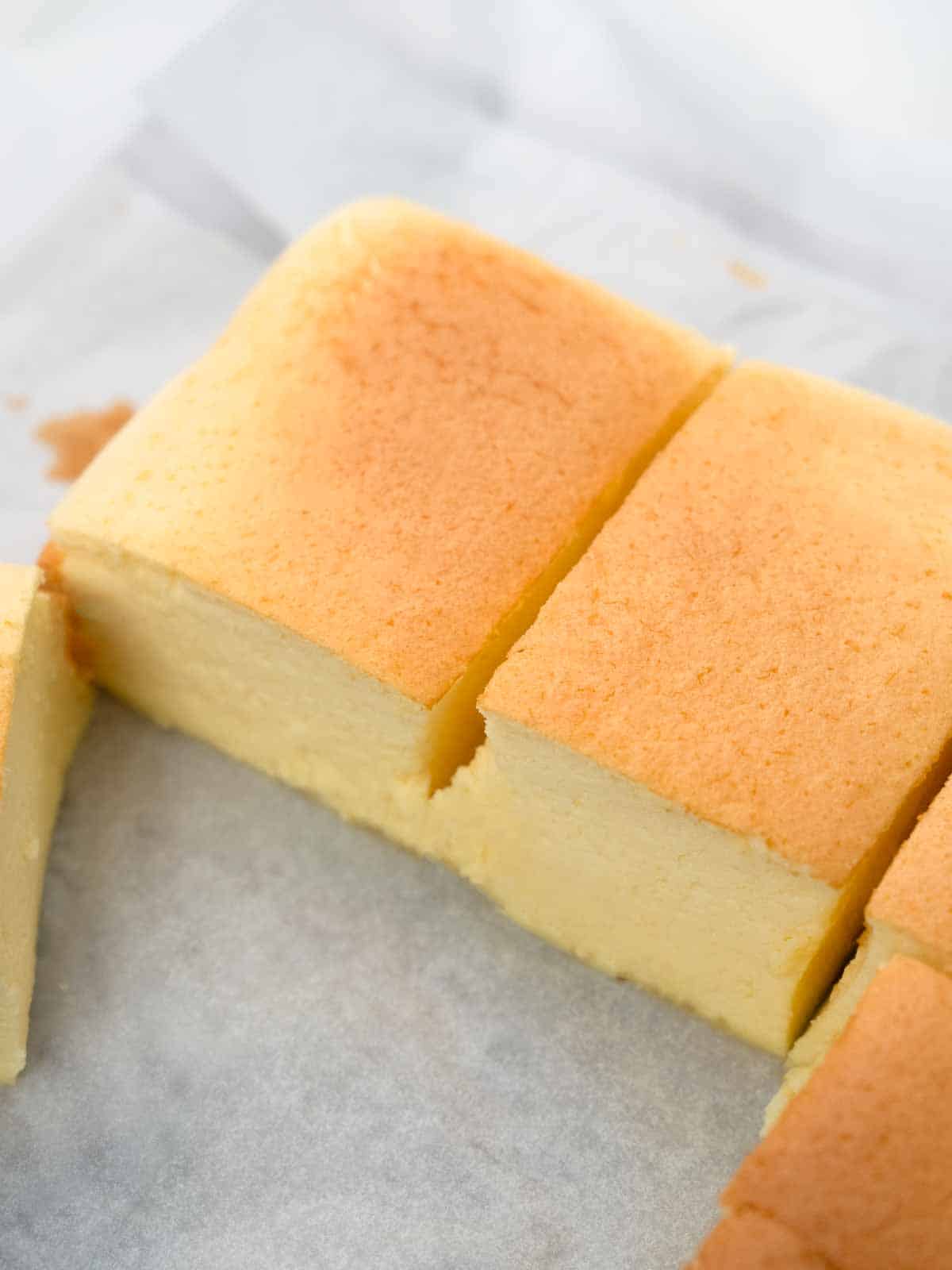
Ingredients
- Cream cheese: I always use Philly cream cheese as I trust that brand the most. If you do use a different kind of cream cheese make sure it's the block kind
- Unsalted butter: Make sure your butter is at room temperature otherwise it will make it very hard to incorporate into the cheese mixture
- Whole milk: Milk helps to loosen up the cream cheese and butter mixture while also adding moisture to the cake
- Large eggs: Make sure you use large eggs as I've specifically developed this recipe to be made with eggs that are at 700g
- Cake flour: Cake flour gives the cake a lighter texture and crumb! If you don't have access to cake flour you can also use regular cake flour, there will be a slight difference in texture but it will be equally as delicious
- Cornstarch: Cornstarch helps to lighten the texture of the cake to give it an even fluffier crumb
- Sugar: The sugar gives the cake sweetness, but it also acts as a stabiliser for the egg whites when they are being whipped. The egg whites need to be as stable as possible for the best rise without cracks
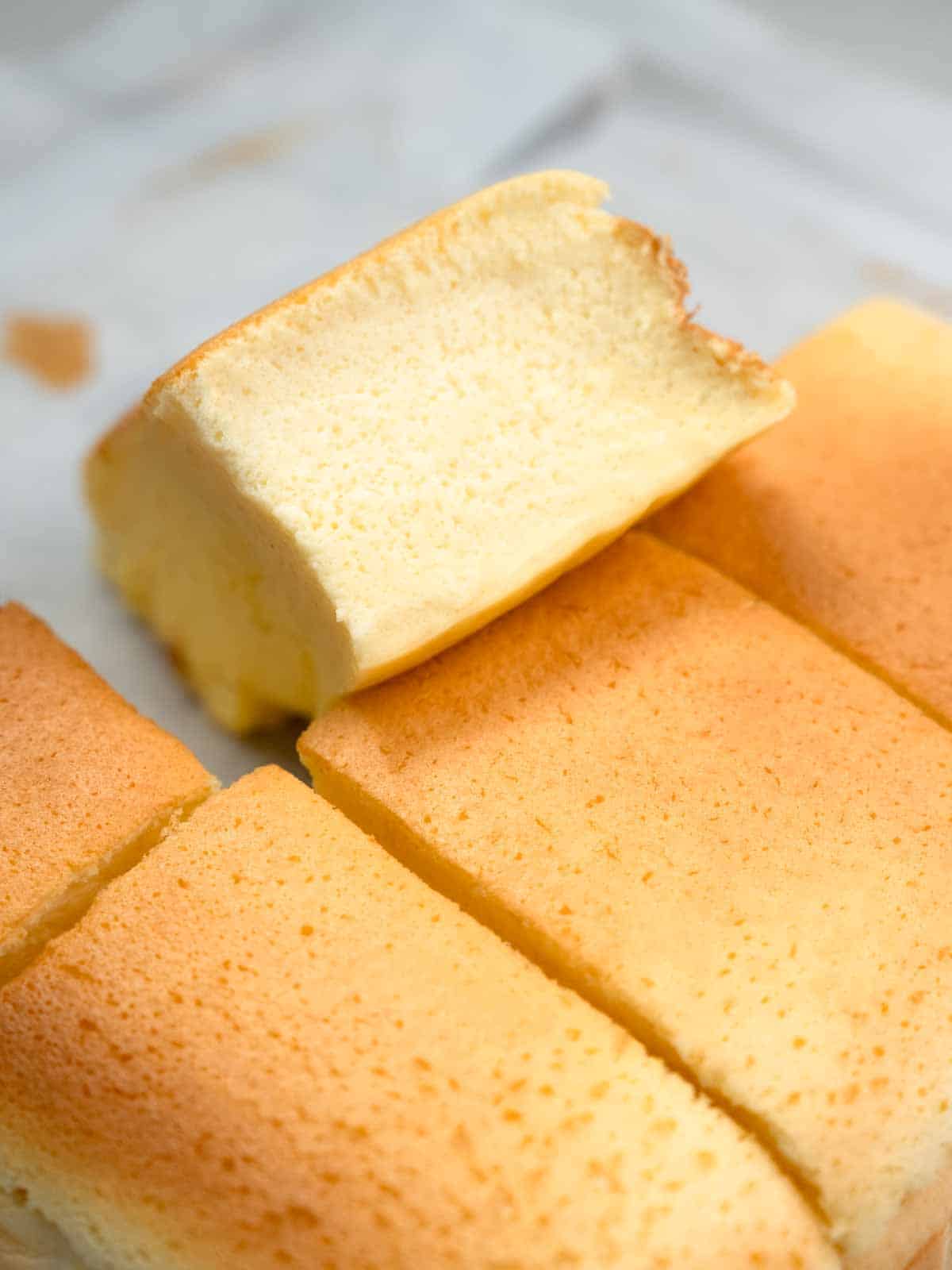
Frequently Asked Questions
What is the difference between regular cheesecake and Japanese cotton cheesecake?
There are a few major differences between the two cheesecakes. Japanese cheesecakes are light cheesecakes made by folding egg whites through a cream cheese-based cake batter. This makes the resulting cake very soft and fluffy while having a creamy cheesecake flavor.
Unlike Japanese cheesecakes, regular cheesecakes have a base made from crushed buttery cookies, which is then topped by a much richer, dense cream cheese batter. This batter is heavily based off cream cheese and held together by eggs or gelatine. The resulting cake is a much heavier, denser, and cheesier cake.
Why is my cheesecake not fluffy?
The airy texture comes from the folding of whipped egg whites through the batter. However, if the egg whites are not folded properly it can result in a dense cake.
If you under-mix the egg whites into the batter you will have a cake with a dense bottom and light top. This is as the heavier cake batter will sink to the bottom of the cake while baking, while the egg whites that hadn't been fully folded through rise to the top.
Over-mixing the batter causes the whipped egg whites to deflate. The signature soft and fluffy texture comes from the air whipped into the egg whites. Without the extra air the cake will not be able to rise resulting in a flat and dense cake.
Why did my Japanese cheesecake crack?
There are a few reasons why your cheesecake cracked, however it largely comes down to temperature control. As the texture of the cheesecake is so delicate it is important to watch the baking temperature of the cake as it bakes.
There are a lot of different ways to bake Japanese cheesecakes. Some recipes start on a lower temperature and increase it at the end to give it a browned color. Others will do it the opposite way.
Personally, I prefer to start at a higher temperature. This gives the cake the initial rise. The most important step when baking your cake like this is opening the oven door.
Opening the oven door releases any built-up steam. This is what causes the cake to crack. By releasing that steam you are preventing the cake from rising excessively and for the remainder of the time it will bake slowly at a more even pace.
How should I serve this cake?
This cake can be served fresh from the oven warm. Or served after it's been chilled for a couple hours for a firmer cheesier flavor. I like to serve it with a side of whipped heavy cream and some fresh berries for a perfectly balanced dessert!
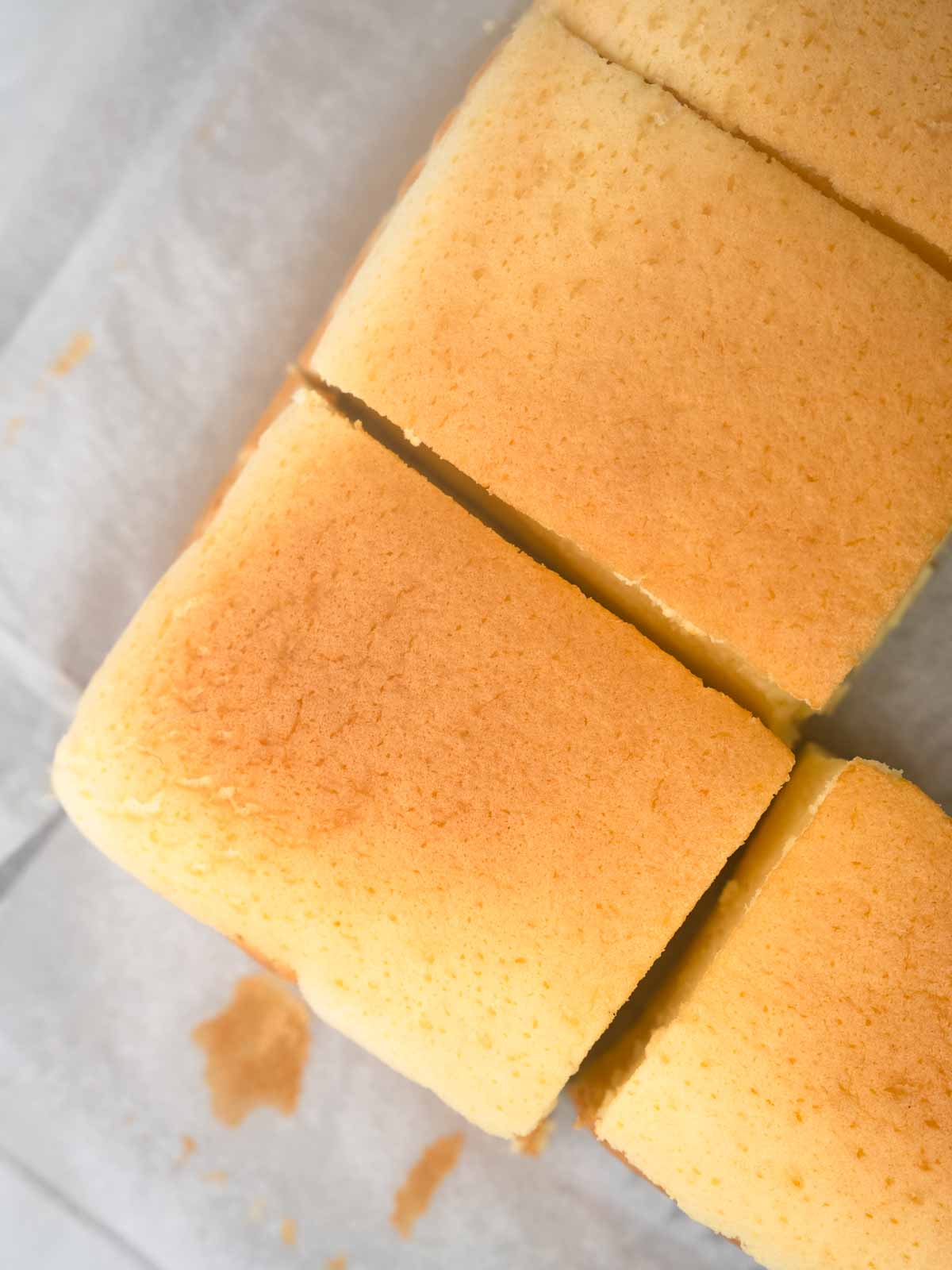
Let's Get Baking!
I feel like I've written an essay on cheesecakes at this point... Anything to make sure you all have the necessary tips for a perfect soufflé cheesecake!
If you liked this recipe make sure to leave me a comment and rating down below, I would love to know how you went.
Also, don't forget to tag me on Instagram @catherine.desserts and hashtag #cattycakes so I can see and share your desserts. Follow me on Facebook, Pinterest, Youtube, and TikTok for more of my baking creations and updates! Until next time... happy baking!
PrintJapanese Souffle Cheesecake
Japanese-style souffle cheesecake. This cotton soft cheesecake is full of creamy cheese flavour with a light melt-in-your mouth texture. The softest cheesecake you'll ever have!
- Prep Time: 20 minutes
- Cook Time: 90
- Total Time: 1 hour 50 minutes
- Yield: 8 x 8 inch cake 1x
- Category: Cake
- Method: Intermediate
- Cuisine: Japanese
Ingredients
- 300g Cream cheese, room temperature (10.5oz)
- 50g Unsalted butter, room temperature (3 tbs 1 tsp)
- 160g Whole milk (⅔ cup)
- 5 Egg yolks
- 35g Cake flour (⅓ cup)
- 15g Cornstarch (1 tbsp)
- Pinch of salt
- 5 Egg whites
- 110g Sugar (½ cup 1 tbsp)
Instructions
- Preheat the oven to 200C / 390F
- Line the bottom and sides of an 8-inch square cake tin with parchment paper
- Bring a small saucepan of water to a simmer
- In a medium heatproof bowl add the cream cheese, butter, and milk
- Mix the ingredients with a whisk until slightly melted, then whisk until smooth
- Remove from the hot water bath and add the egg yolks
- Sieve in the cake flour and cornstarch, add the salt and mix until smooth
- In the bowl of a stand mixer add the egg whites and sugar, and whisk on medium speed until soft peaks
- Reduce the speed to low and beat for 2 minutes, this gets rid of any big air bubbles in the beaten egg whites
- Add one-quarter of the meringue to the cream cheese batter and whisk until smooth
- Transfer the cream cheese batter to the remaining meringue and fold carefully with a spatula until well combined
- Pour the batter into the prepared cake tin, then place the tin in a slightly larger baking tray
- Fill the baking tray with boiling water, reaching 1-2cm up the side of the cake tin
- Place the tray in the oven and bake for 15 minutes
- Open the oven door to release steam and place a wooden spoon or folded teatowel in the oven door to keep it ajar
- Reduce the heat to 110C/230F and bake for a further 70-80 minutes, until the top is golden brown
- Remove from oven and transfer to a wire rack to cool
- Enjoy warm or place in the fridge for 3-4 hours to enjoy chilled

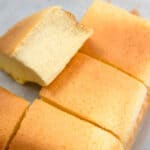
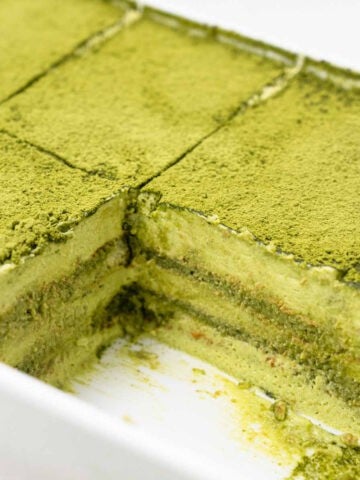
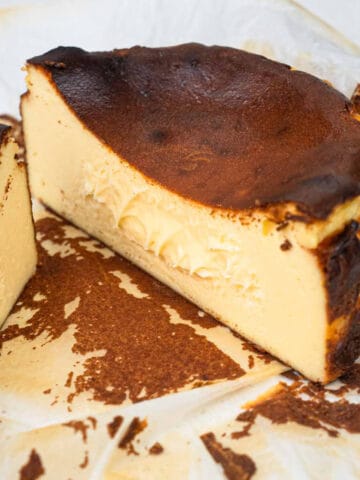


Silvana
Hi, Did you use a springform or regular cake pan?
Catherine Zhang
I used a regular cake pan, springform pans may cause the waterbath to leak into the cake. Hope that helps!
aura leona
Why does it always come out undercooked? I even baked it for 1hr 45mins for 110C and its still super soft and wet. 😭 Im using a convection oven. Please help
Catherine Zhang
Hi Aura, I would recommend reducing the amount of water in your waterbath, as when there is too much it can cause the cake to underbake. Hope that helps!
Kaz
What is cake flour please? We don’t have this in the UK 🙁 Thank you! It’s looks amazing
Catherine Zhang
Hi Kaz, Cake flour is also known as low protein flour and used to make cakes lighter. You should be able to find it in the flour aisle of most supermarkets!
Roland
I love this so much!
Catherine Zhang
Thank you!
Anastasia
Hi Catherine
Just wondered if I doubled the ingredients could I bake the cake in an 8 inch or 9 inch pan and for how long ?
Catherine Zhang
You can double the ingredients for a 9-inch cake! I'm not too sure how long it will take but I'd try baking it after the initial low bake at the increased temp of 150C/F for a further 45 mins or so.
huiying
Would the souffle cheesecake hold up to being sliced and layered (similar to a japanese strawberry shortcake)?
I had a souffle cheesecake + sliced fruits and whipped cream layered in between and it was phenomenal (dare say better than the traditional japanese strawberry shortcake) and would like to try it out!
Catherine Zhang
Yes it definitely would! Make sure you chill the cake completely before slicing into it 😊
Clarissa
Hi! I only have an 8-inch round pan, so how do I alter the recipe? Also, I keep breaking the yolks when separating the eggs 😭 how do I reduce that?
Catherine Zhang
I would increase the recipe by 1.5x. Try cracking the eggs in a bowl and scooping out the egg yolks with your hands 😊
Susu Lo
Hi Catherine. This is the second time I’ve made this cake (Japanese soufflé cheesecake) from your book. The cakes were delicious! However they did not rise the way they should. They were kind of consistently dense but still tasted good … lol.
So I compared the recipe from the book to this one n realised they are quite different especially the temperatures. Book is consistent at 320F throughout but your web version starts at a way lower temperature, etc etc.
Can you please clarify? Thanks for all the delicious recipes xoxo
Catherine Zhang
Hi Susu, so I've actually updated the recipe in the book to a better and improved version. Both recipes work but the book one turns out fluffier and more consistent!
Kristin R
I just made this from the recipe in the book and it was fantastic. Hubs said it was more chiffon cake before refrigerating but after that he said it was perfect. He recently discovered uncle tetsu and lives their cheesecake. He said this was better, now he wants flavors and is asking for strawberry.